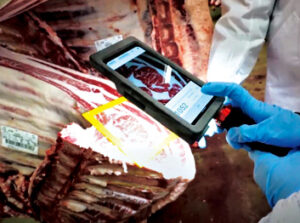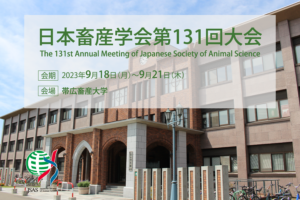June 2023: Feature on Jiji Press
Our collaboration with Fukushima Prefecture on the improvement of meat quality analysis was featured on a Jiji Press article released yesterday.
The translation of the article follows below:
In cooperation with Obihiro University of Agriculture and Veterinary Medicine, Fukushima Prefecture has developed a system that can evaluate the meat quality of cattle from the growth stage using artificial intelligence (AI) technology. Typically, cattle are judged by their fat content (sashi) and color after shipping and disassembly, but if cattle can be evaluated in advance with high accuracy, it will help determine when to ship them and reduce costs. Megumi Hara, from thePrefectural Agricultural Center’s Livestock Research Institute, is enthusiastic, saying, “We want to strengthen the competitiveness of prefectural cattle, which have been weakened by the earthquake.”
Beef is graded according to the quantity and quality of meat from one animal. In the past, ultrasonic waves have been applied to cattle before shipment to check their condition to be marketed with better quality meat. However, “it is human beings who make the judgment. It takes experience, and there are considerable differences among individuals,” says Hara.
The prefecture and others began developing a system in 2019. The system uses ultrasound images of 22- to 24-month-old cows from the back to the abdomen, and evaluates the cows’ current meat quality and future “growth potential.” If the AI evaluations are positive, the farmers can use them to reduce feed costs and improve the turnover rate of their barns by shipping the cattle earlier. In contrast, if the AI evaluations are negative, they can prepare their cattle for a cattle show.
Isao Nukai, 73, a fattening farmer in Date, Hyogo Prefecture, trusts AI, saying, “AI is just like a good connoisseur.” He continues, “I used to just ship calves in the order I bought them,” but with the introduction of the system, “I can look at the data and devise ways to change the order in which they are shipped.
Since the accident at TEPCO’s Fukushima Daiichi Nuclear Power Plant in 2011, the price of cattle produced in the prefecture has stagnated. According to the prefectural livestock department, the gap between the national average and the cost per kilogram, about 300 yen immediately after the accident, has gradually narrowed but was still about 90 yen lower as of January of this year. It is difficult to say that prices have returned to pre-disaster levels.
Soaring prices for feed and other commodities are driving up production costs, such as the purchase price of calves, and intensifying competition among production areas. Hara pointed out that “the key to improving brand power is to have a stable supply of high-quality cattle and to have a large number of prize winners at cattle fairs. We would like to improve the system’s accuracy by having the AI relearn actual evaluations.”
For the full Japanese article, check out here.


